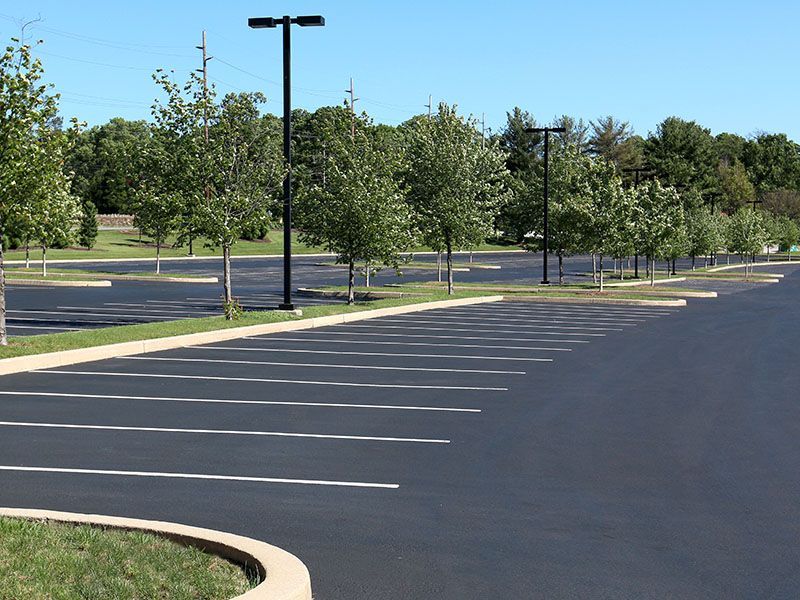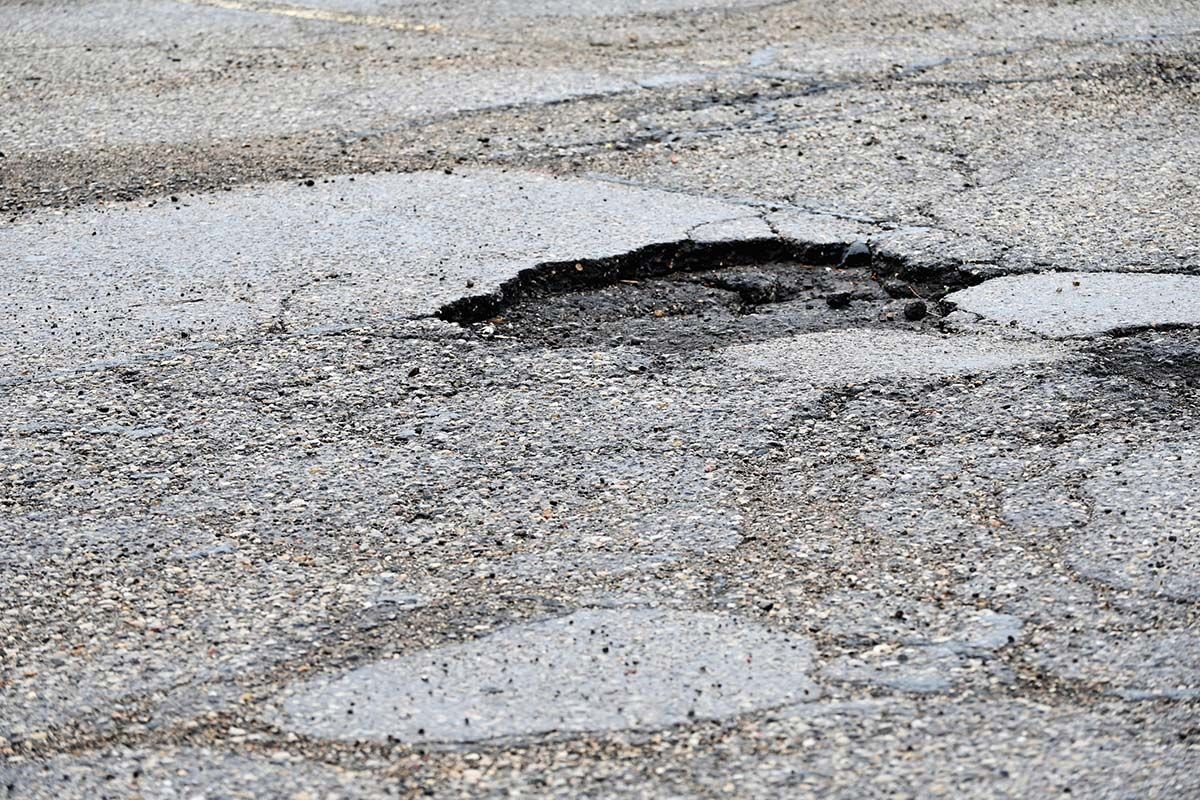Ensuring Accessibility: A Guide To ADA Parking Requirements
Ensuring that every visitor can park and access facilities is a top priority for property managers. Accessible parking isn't just a courtesy; it's mandated by the Americans with Disabilities Act (ADA).
This guide will outline what you need to know about ADA requirements for parking spaces, helping you maintain compliance and inclusivity. Read on for clarity and peace of mind!
Key Takeaways
• Commercial properties must have at least one ADA - compliant parking space for every 25 spaces, and the number of accessible spots increases with the size of the lot.
• Accessible parking spaces require a width of 96 inches, while van-accessible spots need to be 132 inches wide with a 60-inch-wide access aisle. All areas must have a minimum vertical clearance of 98 inches.
• At least one out of every six accessible parking spaces should be van - accessible. These are wider to accommodate vehicles equipped with ramps or lifts for wheelchairs.
• Medical facilities must allocate 10% of their parking for patients and visitors as accessible spaces. Outpatient facilities need one van-accessible spot per six accessible places.
• Property managers can utilize resources like The Ultimate Guide to ADA - Compliant Parking Lots for guidance on maintaining compliance and making sure all designated parking meets legal criteria.
What is ADA?
The Americans with Disabilities Act, commonly known as the ADA, serves as a landmark civil rights law that prohibits discrimination and ensures equal opportunity for individuals with disabilities across various areas of public life.
This groundbreaking piece of legislation has reshaped our communities by mandating inclusive design and accommodations in every corner, from workplaces to parking lots.
Overview of the Americans with Disabilities Act
The Americans with Disabilities Act (ADA) stands as a powerful civil rights law, designed to prevent discrimination and ensure equal opportunity for people with disabilities. It mandates that public spaces, including parking lots and garages, accommodate everyone's needs.
This means creating accessible parking spaces close to entrances so those using wheelchairs or other mobility aids can easily reach their destinations.
Crucially, the ADA calls for ample space for vehicles that are equipped with ramps or lifts in these parking areas. Not only do property managers need to provide these accommodations; they must also maintain them effectively over time.
Compliance isn't just about meeting initial requirements – it involves continuous attention to accessibility as conditions change or standards evolve.
History and purpose of ADA
Enacted in 1990, the Americans with Disabilities Act broke new ground by establishing widespread civil rights protections for individuals with disabilities. It aimed to remove barriers that limited everyday activities, ensuring equal opportunities in public life.
Commercial property managers must recognize the ADA's essential role: it mandates accessible design features across various facilities, including parking garages and multi-level parking structures, that accommodate everyone regardless of physical limitations.
The act's purpose extends beyond just compliance; it represents a commitment to inclusivity and rehabilitation. By requiring reasonable accommodations such as designated ada parking requirements for mobility devices like power wheelchairs, scooters, and other aids like braces or crutches, businesses contribute to a society where all individuals can access services freely.
Accessibility isn't an option—it’s a mandatory facet of modern building standards that enhances usability for people undergoing physical therapy or those permanently reliant on assistive equipment.
Accessibility Requirements for Parking Spaces
Understanding the specific mandates for ADA-compliant parking spaces is crucial, as it ensures that individuals with disabilities have equal access to public and private venues. Clear guidelines dictate the quantity, dimensions, and necessary features of these designated spots to create a welcoming environment for all patrons.
Minimum number of accessible parking spaces
Every commercial property must meet the ADA standards for accessible parking spaces, ensuring that individuals with disabilities have equal access to facilities. The rules are clear: the number of accessible parking spots cannot be less than what is outlined in the guidelines.
For every 25 parking spaces, there should be at least one accessible spot. As the total number of parking spaces increases, so does the required ratio of accessible spots.
Commercial managers need to ensure these minimums are strictly adhered to. For smaller lots with fewer than 25 spaces, a single accessible space is crucial. However, larger lots and garages need more planning—four accessible spaces for up to 100 slots and even more as counts go higher into hundreds or thousands.
This includes making specific accommodations for van-accessible areas which require wider dimensions—a minimum width of 132 inches plus a 60-inch-wide access aisle next to it—to accommodate wheelchair lifts comfortably.
Features and dimensions of accessible parking spaces and access aisles
Accessible parking spaces play a crucial role in serving customers with disabilities, and as commercial property managers, it's vital to meet ADA regulations. Each of these parking spots must be at least 96 inches wide to accommodate vehicles that are equipped for disabled passengers.
Alongside them, access aisles should measure no less than 60 inches across, allowing ample room for maneuvering wheelchairs or other mobility aids.
For those requiring van accessibility, the stakes are higher: spaces need to expand to eleven feet in width. This ensures enough space for side-loading wheelchair ramps and the safe transfer from vehicle to pavement.
It's also essential that each aisle is level with its adjacent parking area and stretches equally long, facilitating an unobstructed path of travel. Moreover, all accessible spots must afford a minimum vertical clearance of 98 inches—guard rails or overhead obstructions simply aren’t options here.
Implementing these features correctly helps secure accessibility for everyone and demonstrates your commitment to inclusion on your property.
Additional Requirements for Different Types of Facilities
Different types of facilities bring their own set of challenges and thus require specific attention when it comes to ADA parking; this includes a deep dive into the nuances for hospitals, medical centers, and considerations for vehicles such as vans or those requiring electric charging stations.
Parking at medical facilities, hospitals, and outpatient facilities
Parking at medical facilities, hospitals, and outpatient facilities is critical for ensuring patients and visitors with disabilities have equal access to care. Compliance with ADA standards here involves dedicating 10% of patient and visitor parking spaces to those that are accessible.
These spots must offer ample room - a minimum width of 96 inches with an adjacent 60-inch wide access aisle to accommodate individuals who require extra space when entering or exiting their vehicle.
Each hospital outpatient facility should provide van-accessible parking as well. For every six accessible parking spaces, or fraction thereof, it’s mandatory that at least one be van-accessible.
This means adjusting for height clearances and ensuring proper signage is in place so these specialized spots are easily identifiable amidst the traffic of multi-level parking garages or expansive surface lots.
Property managers must ensure that slopes do not exceed a 1:48 ratio in all directions within each car accessible space to grant safe navigation for all users.
Van-accessible parking spaces
Transitioning from the specific needs of medical facilities, we come to another critical aspect: van-accessible parking spaces. These are crucial for accommodating larger vehicles that transport individuals with disabilities.
With a minimum width of 96 inches and a side access aisle at least 60 inches wide, these spots ensure enough room for vans equipped with wheelchair lifts or ramps. It's imperative to note that out of every six accessible parking spaces, one must be van-accessible.
Recognizing the importance of proper dimensions is key; van-accessible spaces should measure eleven feet in both spot and aisle width to provide ample space for maneuvering. Commercial property managers need to keep track of this requirement as part of ensuring ADA compliance across their parking lots.
These spaces not only offer convenience but also uphold the inclusivity standards set by regulations.
Electric vehicle charging stations
Electric vehicle charging stations are becoming essential as more people switch to electric cars. As a commercial property manager, you need to ensure that at least one charger is accessible and complies with ADA design guidelines.
This means installing the station in an area with enough space for mobility devices, along with clear and wide access aisles.
These stations not only provide a necessary service but also show commitment to inclusivity. Keep in mind that building managers must integrate these EV spots seamlessly into existing parking lots while making sure they're convenient for use by everyone, including individuals who rely on vans or buses equipped for disabilities.
Proper placement of EV charging stations can significantly enhance the functionality of your establishment’s parking amenities and support sustainable transportation options.
Ensuring Compliance with ADA Parking Requirements
Ensuring compliance with ADA parking requirements is not just about meeting legal obligations; it's a commitment to inclusivity and providing equal access for all patrons. Property managers must proactively maintain accessible parking features, utilize available guidance resources, and stay abreast of related laws to ensure their facilities are welcoming to individuals with disabilities.
Maintenance and upkeep
Regular maintenance of ADA-compliant parking spaces is not just about following the law; it's also a sign of respect for individuals with disabilities. Keep in mind, these designated areas require clear access aisles and must always be kept free from obstructions.
A minimum width of 8 feet allows enough room for vehicle doors to open fully so that wheelchairs and other mobility devices can maneuver without difficulty.
Proper upkeep involves routinely checking painted lines and signage to ensure they remain visible and unambiguous. Faded markings or missing signs can lead to confusion and misuse, which defeats the purpose of having accessible parking in the first place.
As managers, you play a critical role in preserving the integrity of these spaces by promptly addressing wear and tear or vandalism. Remember, accessibility is an ongoing commitment that benefits everyone visiting your property.
Guidance and resources for ADA compliance
Keeping your parking facilities up to ADA standards is crucial for meeting legal requirements and serving customers with disabilities. Start by consulting the Access Board, which offers technical assistance and training tailored to ADA Accessibility Standards for parking spaces.
Their expert guidance ensures that your accessible parking meets federal criteria and supports individuals who rely on these accommodations.
Access comprehensive resources like The Ultimate Guide to ADA-Compliant Parking Lots, a valuable tool for commercial property managers aiming to stripe their lots correctly. If you need to update or restriping parking spaces, this guide walks you through aligning with ADA guidelines while adhering to local codes.
Better accessibility contributes not only to compliance but also enhances convenience for all visitors driving motor homes, recreational vehicles, or using electric vehicle charging stations at your facility.
Other laws and regulations related to accessible parking
Beyond the ADA, property managers must navigate additional laws that shape accessible parking rules. For instance, the Fair Housing Act mandates accessibility in certain residential complexes, which could include designated parking for residents with disabilities.
Some states may have their own regulations that are more stringent than federal standards and require compliance. It's crucial to familiarize yourself with both state statutes and ADA guidelines to ensure your facility meets all necessary requirements.
Airports also follow distinct rules under the Air Carrier Access Act, demanding specific accommodations for travelers with disabilities. Similarly, medical facilities might be subjected to regulations regarding diagnostic equipment access.
Property managers should seek out detailed information on these regulations or consult experts to guarantee they're not only providing adequate access but also avoiding potential legal issues.
This diligence contributes to creating an inclusive environment for all patrons and fosters positive community relationships. Moving forward, let’s look at how ensuring compliance can benefit your facility and its visitors alike.
Contact Asphalt Solutions for ADA Parking Lot Services
Making your property fully accessible isn't just about following the law; it's about opening doors to everyone. Simple steps can create a welcoming environment for individuals with disabilities, ensuring their rights and independence are respected.
Remember, every parking space counts in promoting inclusivity and providing equal opportunities for all visitors. Accessible parking is more than just convenience—it's a commitment to community and equality that speaks volumes about your values as a property manager.
Let's embrace these standards not as mere requirements but as stepping stones towards creating spaces where everyone moves freely and without barriers. Contact us today
to see how we can help!

If you own a parking lot in Indiana, you might be wondering how to make it last longer, save money on repairs, and be more environmentally friendly. Good news—sustainable paving solutions can help with all of that! Whether you're dealing with Indiana's unpredictable weather, rising maintenance costs, or new regulations, eco-friendly paving options can make a big difference for your property. Why Should Indiana Property Owners Care About Sustainable Paving? • Indiana Weather Can Be Tough on Pavement Indiana's climate swings from freezing winters to blazing hot summers, which can take a toll on traditional pavement. The freeze-thaw cycle causes cracks, potholes, and general wear and tear. Sustainable materials, like reclaimed asphalt pavement (RAP) and warm-mix asphalt (WMA), are designed to handle these temperature changes better, keeping your parking lot in great shape for longer. • It’s Good for the Environment (and Your Reputation!) Going green isn’t just about feeling good—it’s about making a real impact. Using recycled materials in paving projects means less waste going to landfills and fewer new raw materials being mined. Plus, eco-conscious businesses and property owners stand out. Customers and tenants appreciate companies that make an effort to be environmentally responsible. • Save Money Now and Later Sustainable paving isn’t just a smart choice for the Indiana environment—it’s also great for your wallet. Using RAP, for example, lowers material costs because it recycles existing asphalt instead of relying on new materials. The National Asphalt Pavement Association (NAPA) reports that RAP can save up to $7.80 per ton of asphalt mix. Plus, sustainable pavement lasts longer, meaning fewer repairs and replacements. • Stay Ahead of Regulations and Incentives Indiana is stepping up its focus on sustainability, and that includes paving projects. Many cities offer incentives like tax breaks or funding for businesses that choose green construction methods. Checking with local officials can help you take advantage of these perks while staying compliant with new regulations. What Are the Best Sustainable Paving Options in Indiana? • Reclaimed Asphalt Pavement (RAP) RAP is a game-changer. It’s made by grinding up old asphalt and reusing it in new pavement. This cuts down on waste, reduces demand for new materials, and lowers costs. Indiana has been a leader in RAP use, with the Indiana Department of Transportation (INDOT) pushing for its inclusion in many projects. • Warm-Mix Asphalt (WMA) WMA is a more energy-efficient way to produce asphalt. Since it’s made at lower temperatures than traditional hot-mix asphalt, it reduces fuel use and emissions. It also allows for paving in cooler weather, extending the construction season—great for Indiana’s unpredictable climate! • Permeable Pavement If your property deals with drainage issues or heavy rain, permeable pavement could be the solution. It lets water soak through the surface rather than running off, which helps prevent flooding and erosion. This is especially useful in Indiana cities like Indianapolis, where stormwater management is a big concern. • Asphalt Millings Looking for a low-cost, low-maintenance solution? Asphalt millings—recycled bits of old asphalt—are durable, weather-resistant, and don’t need as much upkeep as traditional asphalt. They’re a great choice for resurfacing parking lots or driveways without breaking the bank. Planning a Sustainable Paving Project • Start with a Pavement Assessment Before making any changes, take a good look at your existing pavement. Are there cracks? Drainage issues? High-traffic areas that need reinforcement? Understanding these factors will help you pick the best sustainable solution for your property. • Pick the Right Materials for Your Needs Not all sustainable paving options are the same. If drainage is a big concern, permeable pavement might be your best bet. If you’re looking for an affordable way to extend the life of your parking lot, RAP or WMA could be the way to go. Consider your property’s specific needs when making your choice. • Think Long-Term Sustainable paving may have a slightly higher upfront cost, but the long-term savings in maintenance and durability make it a smart investment. Instead of just focusing on the initial price tag, consider how much you’ll save in repairs and replacements over the years. • Look for Incentives Many Indiana cities and counties offer incentives for businesses that use sustainable construction methods. Grants, tax breaks, and rebate programs can help offset the initial costs. Check with your local municipality to see what programs might be available to you. Partnering with Indiana Sustainable Pavement Professionals As a full-service, sustainable asphalt paving contractor based in Indianapolis, Asphalt Solutions will keep your Indiana eco-friendly and in great shape for years to come. Our experts will provide tailored solutions, utilize high-quality materials, and employ industry-best practices to maintain the longevity, aesthetics, and sustainability of your parking area. Plus, our large fleet enables us to handle projects of all sizes in a timely manner. To request a reliable quote, call (463) 348-2492 or request a quote here .

As winter recedes and the vibrant hues of spring emerge, Indiana property owners face a critical period for maintaining their parking lots. The state's climate, characterized by cold winters and humid summers, can significantly impact asphalt surfaces. Timely spring maintenance is essential to ensure durability, safety, and aesthetic appeal. Below are key considerations and actionable tips for effective pavement upkeep this season. Understanding Indiana's Climate Impact on Pavements Indiana experiences a diverse climate with cold winters and hot, humid summers. During winter, low temperatures can cause asphalt to contract, leading to cracks. The freeze-thaw cycles exacerbate this issue, as water seeps into cracks, freezes, expands, and further deteriorates the pavement. Conversely, summer heat can soften asphalt, making it susceptible to ruts and impressions under heavy loads. These conditions can be exacerbated by the use of de-icing chemicals on roadways during wintertime, and necessitate a proactive approach to pavement maintenance, especially during the transitional spring period. Springtime Pavement Maintenance Tips Conduct Thorough Inspections Begin by meticulously inspecting the entire parking lot for signs of damage incurred over the winter months. Look for cracks, potholes, drainage issues, and faded markings. Early detection allows for prompt repairs, preventing minor issues from escalating into costly problems. Address Cracks Promptly Cracks are common after winter due to the freeze-thaw cycles. It's crucial to seal these cracks promptly to prevent water infiltration, which can lead to further deterioration. Utilizing high-quality crack fillers ensures a durable repair, extending the pavement's lifespan. Repair Potholes Potholes not only pose safety hazards but also accelerate pavement degradation. Timely pothole repairs are essential to maintain a smooth and safe surface for users. Professional patching services can effectively restore the integrity of the pavement. Implement Sealcoating Sealcoating acts as a protective barrier against environmental elements, including UV rays, water, and chemicals. Applying a fresh sealcoat every two to three years enhances the pavement's appearance and extends its service life. Spring offers optimal conditions for sealcoating, as temperatures are moderate and conducive to proper curing. Ensure Proper Drainage Effective drainage is vital to prevent water accumulation, which can weaken the pavement structure. Inspect and clear drainage systems, ensuring they direct water away from the parking lot. Address any grading issues that may cause water pooling, thereby safeguarding the pavement from moisture-related damage. Refresh Pavement Markings Over time, pavement markings can fade due to weather exposure and traffic. Repainting lines, arrows, and symbols not only enhances the aesthetic appeal but also ensures compliance with safety standards, guiding drivers and pedestrians safely and effectively. Additional Considerations Environmental Impact : Be mindful of the environmental implications of pavement maintenance. For instance, parking lots contribute to urban heat islands by absorbing and re-radiating heat, leading to higher local temperatures. Implementing green infrastructure, such as pervious pavements, can mitigate these effects by allowing water infiltration and reducing heat absorption. Regular Maintenance Schedule : Establishing a routine maintenance schedule ensures that inspections and repairs are conducted consistently. Regular upkeep not only prolongs the pavement's lifespan but also enhances safety and reduces long-term costs. The Advantages of Using Professional Maintenance Services Spring serves as a pivotal time for Indiana property owners to assess and maintain their parking lot pavements. Partnering with experienced professionals further ensures that your maintenance efforts are executed with expertise and precision, providing peace of mind and a well-maintained property. Asphalt Solutions offer comprehensive services, including asphalt paving, patching, sealcoating, and more, ensuring your pavement remains in optimal condition. Our experts will provide tailored solutions, utilize high-quality materials, and employ industry-best practices to maintain the longevity and aesthetics of your parking area. Plus, our large fleet enables us to handle projects of all sizes in a timely manner. To request a reliable quote, call (463) 348-2492 or request a quote here .

Maintaining a pristine parking lot is essential for Indiana businesses, as it not only enhances curb appeal but also ensures safety for patrons and employees. Potholes, if left unaddressed, can lead to vehicle damage, pose tripping hazards (and the unwanted legal liability that follows), and reflect poorly on your establishment. Implementing effective pothole prevention and repair strategies is crucial to uphold the integrity and appearance of your parking area. Why Indiana’s Weather Encourages Potholes Freeze-Thaw Cycles: Indiana experiences harsh winters with frequent freeze-thaw cycles. When water seeps into small cracks in the pavement and freezes, it expands, pushing apart the asphalt. When the ice melts, it leaves voids beneath the surface. Over time, traffic pressure causes these weak spots to collapse, forming potholes. Heavy Rainfall & Moisture: Indiana receives significant annual rainfall, which can accelerate pavement deterioration. If a parking lot has poor drainage, standing water can penetrate cracks and erode the asphalt from within. The more water that enters, the more vulnerable the pavement becomes. Snow Removal & Deicing Chemicals: Snowplows and de-icing agents (like salt and calcium chloride) are essential for keeping parking lots safe in winter, but they can also contribute to pothole formation. Snowplows can scrape and weaken the pavement, while deicing chemicals can break down asphalt over time, making it more susceptible to moisture penetration. Temperature Fluctuations: Indiana’s weather can swing from one extreme to another, with warm daytime temperatures followed by freezing nights. This rapid temperature shift stresses the pavement, leading to cracks that eventually turn into potholes. Heavy Vehicle Traffic: Parking lots endure constant traffic, including heavy trucks for deliveries and maintenance. The pressure from these vehicles weakens already compromised pavement, accelerating pothole development. Poor Drainage Systems: Standing water is a major culprit in pothole formation. If a parking lot lacks proper drainage, water pools on the surface and seeps into the pavement, leading to structural weakening. By understanding these factors, property owners can take proactive steps—such as sealcoating, crack filling, and ensuring proper drainage—to extend the lifespan of their parking lots and minimize pothole damage. Preventative Measures Regular Inspections : Conduct routine assessments of your parking lot to identify and address minor issues before they escalate. Early detection of cracks or surface irregularities allows for prompt repairs, preventing the development of potholes. Sealcoating : Applying a protective sealcoat acts as a barrier against water, oils, and UV rays, extending the lifespan of your asphalt. Sealcoating not only enhances the appearance of your parking lot but also prevents cracks and potholes from forming. Crack Sealing : Addressing cracks promptly is vital to prevent water from penetrating the pavement. Utilizing proper crack sealing techniques can significantly extend the pavement's lifespan and reduce long-term maintenance costs. Proper Drainage : Ensuring adequate drainage systems prevents water accumulation, which can accelerate pavement deterioration. Regularly inspect and maintain drainage infrastructure to keep your parking lot free from standing water. Repair Techniques When potholes do occur, timely and effective repair is essential to maintain safety and prevent further damage. Here are some recommended repair methods: Pothole Patching : This involves cleaning the affected area, removing debris, and filling the pothole with appropriate patching material. Proper patching prevents accidents, vehicle damage, and reduces liability for property owners. Resurfacing : For parking lots with extensive wear but structurally sound bases, resurfacing provides a new layer of asphalt over the existing surface. This process extends the life of your parking lot and enhances its appearance. Full-Depth Reconstruction : In cases where the pavement has significant structural damage, a complete reconstruction may be necessary. This involves removing the existing pavement and rebuilding the foundation before laying new asphalt. Partnering with Professionals While some maintenance tasks can be managed in-house, collaborating with experienced paving professionals ensures that your parking lot receives comprehensive care. As a full-service asphalt paving contractor based in Indianapolis, Asphalt Solutions will keep your Indiana parking lot free of potholes for years to come. Our experts will provide tailored solutions, utilize high-quality materials, and employ industry-best practices to maintain the longevity and aesthetics of your parking area. Plus, our large fleet enables us to handle projects of all sizes in a timely manner. To request a reliable quote, call (463) 348-2492 or request a quote here .
Managing stormwater is a crucial challenge for commercial property managers. Catch basins play a vital role in this process by storing and transporting rainwater and runoff. This article will guide you through understanding how catch basins work, their benefits, and maintenance tips to keep your paving areas safe from flooding. Keep reading to discover more about enhancing water management on your property.







